
Iran holds the world’s second largest gas reserves in the world after Russia and is planning to build the $4bn Pars gas pipeline to transport much of this through Europe. If the plan goes ahead, it will rival the EU-backed Nabucco pipeline, which runs 3,300km from Turkey to Austria, and Russia’s 3,200km South Stream pipeline.
The diameter of the Pars pipeline will be around 56in and it will have an initial designed capacity of 37 billion cubic metres per annum. The volume of gas Iran proposes to supply to south and central European countries will be 20% more than its rivals Nabucco and South Stream, according to market analyst GlobalData in its “Iran Plans to Build New Gas Pipeline to Europe: Further Troubles for European Union’s Nabucco Gas Pipeline” report.
However, as well as logistical planning, Iran would do well to take the time to implement comprehensive security and an anti-terrorism infrastructure.
Likelihood of attack
Iran plans to come up with a new route to pump gas from the border point of Bazargan to Turkey. This infrastructure will then be connected to its own transmission pipeline and the gas will pass through Greece to Italy, and via Switzerland to Austria and Germany.
See Also:
Iran will avoid the Eastern European route because many countries along this path are participants in the Nabucco and South Stream pipeline projects.
How well do you really know your competitors?
Access the most comprehensive Company Profiles on the market, powered by GlobalData. Save hours of research. Gain competitive edge.

Thank you!
Your download email will arrive shortly
Not ready to buy yet? Download a free sample
We are confident about the unique quality of our Company Profiles. However, we want you to make the most beneficial decision for your business, so we offer a free sample that you can download by submitting the below form
By GlobalDataDespite international sanctions, Iran seems to be well placed in its plan to develop the Pars gas pipeline. However, that does not mean it will be a popular development. Securing its safety as a critical asset must therefore be paramount in Iran’s thinking.
Kinder Morgan corporate security manager Duane Jones says attacks on pipelines in the USA, where he is based, are rare, but elsewhere it is a different story.
“One thing to recognise is that pipelines in Iraq and the Middle East are constantly under attack where the threat environment is very different,” Jones says.
The adversaries are intelligent and recognise what is and is not valuable, and what is worth spending resources on. For some, a pipeline that can be repaired within a couple of days would not be worthy of investment, but for others wanting to make a splash against Iran’s development into mainstream supply and demand markets, it just might.
Critical protection
Iran’s nuclear development plan has drawn criticism from many, including the USA and UN. This has resulted in sanctions and political pressure from the USA, which has compelled most European countries to stop supplying raw materials and technology for Iran’s energy sector development.
The sanctions have also hit Iran’s plan to develop its LNG industry as most of its European partners have withdrawn their support from different LNG projects. In May 2008, pressure from the US Government prevented Royal Dutch Shell and Repsol investing $10bn in the Persian LNG project. In the absence of these LNG terminals, the only option left for Iran is to export its abundant natural gas to the high demand markets in southern and central Europe through the new pipeline.
Becoming so unpopular, however, increases the risks to Iran’s infrastructure, especially when it crosses international land. Jones says that incidents such as the Ejército Popular Revolucionario’s attempt to disrupt Pemex’s supply in Mexico by exploding sections of pipe and the JFK pipeline terror plot targeting New York, both in 2007, gave the public the impression that attacks on oil installations can be dramatically
disruptive.
While this may not be wholly true in practice, investment in surveillance equipment is critical. This is not only true for protecting installations against attacks but also making sure there is an awareness when spills occur and, in the USA at least, for meeting regulations.
“We have used CCTV systems but these are generally only as good as the people watching them,” Jones says.
Instead, he has taken Kinder Morgan down the route of using smart camera systems that send alarms to guards when there are pixel distillations or if critical assets in the frame, such as a valve or door handle, move.
Industry standards
In the USA, the ‘terror effect’ has resulted in a drive towards more stringent regulations – a factor that Jones says will drive spending in this sector in years to come. In addition, there is the push for there to be a similarity between the security arrangements at varying oil installations across the country.
“Generally, we strive to meet the industry standard because if we all look alike and have the same types of structures, it reduces the potential of having it be a soft target,” Jones says.
Having a standard surveillance and protection system along the course of the pipeline will stand Iran in good stead to cross so many international borders and regulations. Due to the route it is taking, the pipeline will be able to keep itself away from tariff disputes, which generally affect the consumers in terms of heightened gas bills or disruption of gas supplies.
Many European countries such as Turkey, Switzerland, Austria, Germany, Italy and Greece are interested in buying natural gas from Iran. It promises to be a secured gas supply at a reasonable price and therefore has many promoters. But Iran’s history is far from squeaky clean and while many will view any development as a positive step, there will be those that are against the project – and will want to vent their anger.




